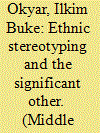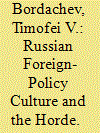| Srl | Item |
| 1 |
ID:
174901


|
|
|
|
|
| Summary/Abstract |
This article examines about a hundred cartoons published during the decade long Kurdish insurgency in the eve of the establishment of the Republic of Turkey from 1925-1938. It attempts to assess how the relational construction between colloquial culture, the cultural construction of national characters and the state discourse are intertwined in defining the self and the other in the development of Turkish national identity. The article seeks to highlight the importance of previously neglected late Ottoman and early Republican colloquial Turkish political cartoons. This approach is crucial to any attempt at capturing the voice of nationalist discourse in the early Republican period, where the perceived image of the Kurd as the significant internal other is tainted forever by its supremacist origins.
|
|
|
|
|
|
|
|
|
|
|
|
|
|
|
|
| 2 |
ID:
197095


|
|
|
|
|
| Summary/Abstract |
When the Quadrilateral Security Dialogue (Quad) was resuscitated in November 2017, it was framed as a minilateral grouping of liberal democratic countries to build a free and open Indo-Pacific in the shadow of China’s growing assertiveness. However, this Quad 2.0 had not taken collective action until 2021. The four states neither held leaders’ summit meetings nor issued joint statements after lower-level meetings. They took no joint quadrilateral actions to deter China either. From a constructivist perspective, this paper addresses this puzzle by critically revisiting the alleged common identity of the four states. It argues that India’s national identity has not been built on the ontological difference between liberal democracy and autocracy but on a complex amalgamation of non-alignment, post-imperial ideology, Hindu nationalism and Indian exceptionalism. India, having held a vision of establishing an India–China partnership in Asia, did not regard China as its significant Other until the deadly border clashes between them in June 2020. China’s expansionism has challenged India’s identity as the pre-eminent power in South Asia and its vision of an equal China–India partnership. Despite India’s increased cooperation with its Quad partners since then, the Quad is built more on geopolitical pragmatism than on shared liberal norms and values.
|
|
|
|
|
|
|
|
|
|
|
|
|
|
|
|
| 3 |
ID:
189864


|
|
|
|
|
| Summary/Abstract |
This article scrutinizes the historical impact of the Mongolian Horde on
Russia’s foreign policy behavior. The author comes up with a hypothesis
that relations with the Horde were not only important for Russia during
the critical historical period of its formation, but also largely determined
its unique foreign-policy culture and practical implementation of Russian
foreign policy in subsequent periods. The author maintains that the key
element of this impact was peaceful integration of the powerful neighbor
which posed the biggest threat to the Great Russians for more than two
hundred years.
|
|
|
|
|
|
|
|
|
|
|
|
|
|
|
|